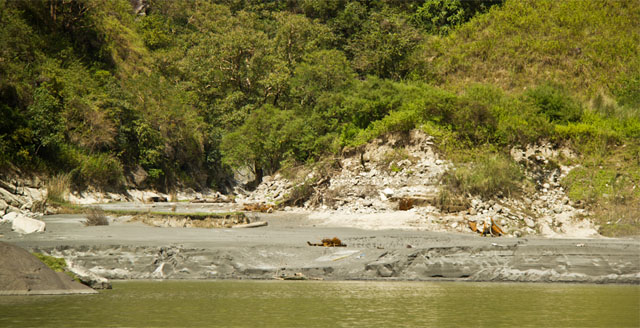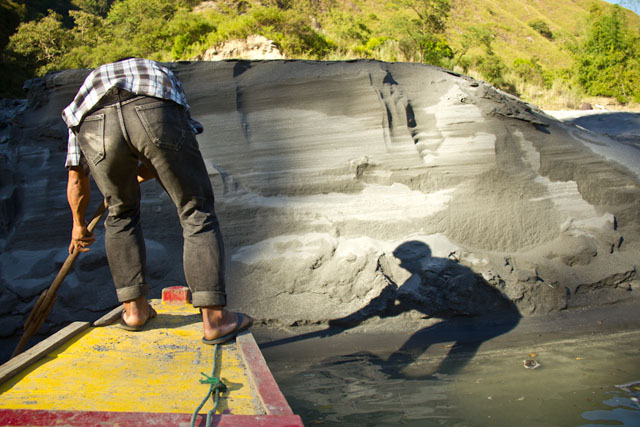Filtered By: Topstories
News
After Philex mine spill, a world of gray
By ROUCHELLE R. DINGLASAN, GMA NEWS

Residents of Sitio Pangbasan take a break from searching for scrap metal found along the creek. Photos by Br. Jun Santiago
The color is courtesy of Philex Mining Corporation’s mine tailings, or waste material, from its Padcal gold and copper mine operations in Itogon, Benguet. Amid torrential rains in early August, the mine’s lone operating tailings pond – a dam containing wastewater and sediments from the mining operations – leaked its waste into nearby water channels, allegedly destroying ecosystems, and livelihoods along the way.
After the first major leak, four other spills have been reported until September. The Department of Environment and Natural Resources (DENR) earlier estimated that 20.6 million metric tons of sediment were discharged from the Philex operation.
About three months after the incident, Philex claimed to have plugged its leak last October 18.
Be that as it may, Balog Creek appears to have taken the worst of the discharge, with most of the sediments deposited along the 2.5-kilometer water channel.
The mine tailings look like the common gray sand used in construction projects. They’ve built up along the sides of the creek, constructing themselves into a five-foot high cement-like embankment.
Visitors, unaware of the tailings spillage, may think the sediment build-up is natural to the creek. However, it was reported that exposure to the gray sand brings an itch.
This reporter nervously starts to scratch.

The gray sandy sediment from the damaged tailings pond build up on riverbank.
‘Biologically dead’
An environmental investigative mission (EIM) studying the creek, which is connected to the Agno River and the San Roque Dam, has come out with its preliminary findings.
In a media briefing on Monday, Feny Cosico, agriculturalist and spokesperson for Samahan ng Nagtataguyod ng Agham at Teknolohiya Para sa Sambayanan (Agham), confirmed the ocular impressions of a non-scientist – the Balog Creek is dead.
Cosico explained that the sediments and wastewater from the August 1 tailing pond leakage “covered the biodiversity in the Balog Creek.”
“Our firsthand observations of the river system in Balog creek tells us that the river may be considered biologically dead. There was no sign of living things or any form of life found in the river,” she noted.
“There is a high concentration of toxic substances. Because of the turbidity of the water, sunlight could not penetrate the riverbed causing the normal biological processes needed to maintain life to cease,” Cosico explained.
There was also thick sedimentation and a rotten fish smell in the creek, she added.
Cosico warned that the sediments from the tailings pond may contain “heavy metals and flotation reagents that are toxic to plants and animals.”
The EIM team has yet to release the official water and sediment test result from the samples gathered during the independent investigation carried out October 26 to 28.
The EIM was organized by Cordillera Peoples Alliance, Amianan Salakniban, KATRIBU Indigenous Peoples Partylist, RDC Kaduami, Kalikasan People’s Network for the Environment, Center for Environmental Concerns, Bantay Amianan, and Agham.
Meanwhile, Padcal Mine spokesperson Eduardo Aratas, disputed the EIM’s initial findings.
He told GMA News Online in a separate interview that only about one to two tons of silt have been deposited along the Balog Creek.
Furthermore, the Balog creek was “not active” even before the spill, having “no fishing activity” along it. That's not what local residents say. 

A fisherman docks at the tailings build-up along Balog Creek.
Social Impact
Gold panning and fishing were the main sources of livelihood among the 45 households of Sitio Pangbasan and four other sitios of Barangay Dalupirip in Itogon, Benguet. The residents live by the convergence of the Balog Creek and the Agno River.
After the mine spill, the residents complained of “zero fish catch.”
Philex also warned them against panning for gold. They were told that they could return to this activity once the tailings waste was removed from the creek.
Apart from the company’s warnings, the residents couldn’t really pan for gold as the creek’s water level remained high. It should have subsided by now. They also believe that they were less likely to find gold as waste sediments from the mine spill covered the riverbed.
The residents are also worried over the creek’s brownish gray color, its rotten fish, and chemical or medicine smell.
As of this story’s posting time, there are no reported cases of illnesses directly attributed to the spill. However, some residents complained of skin rashes, nausea and head aches after having some form of contact with the water.
Meanwhile, the EIM initial report noted that Philex provided for a one-time food assistance package and medical mission. The mining firm also provided short-term alternative livelihood for the residents -- contractual clearance operations which lasted eight days.
Philex promised more contractual construction work; they’re going to build a footbridge within the affected area.
In the meantime, Philex buys scrap metal from the locals at P13.75 per kilogram. They kept on finding these scraps in the water channel. Apparently, they came from Philex’s attempts to plug the tailings pond leakage.
A resident recalled how they came across a one-ton hunk of scrap metal. Another said that about 10 people managed to carry a bulldozer blade they found. To sell these large pieces of metal, acetylene torches were used to chop it down into smaller, manageable sizes.
Last September, the DENR slapped the Manuel V. Pangilinan-led Philex with a P1-billion fine for its tailings pond spillage.
However, Philex contested the DENR’s penalties, with the Mines and Geosciences Bureau yet to consolidate its final report on the incident. — DVM/HS, GMA News
More Videos
Most Popular



